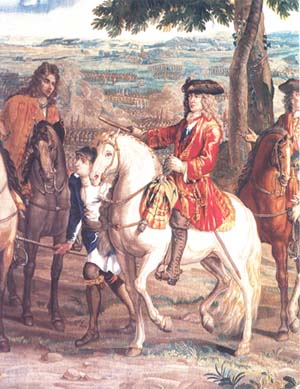
British military history in the eighteenth century begins in the shadow of King James II, who had built up a royal standing army to overthrow Protestant leadership, despite overwhelming national opposition. After James fled the country to be replaced by William of Orange, Parliament was more than wary about having a large army that the monarchy could use to wield absolute power. Thus, despite the four major wars and various internal rebellions that occurred in the Eighteenth century, the size of England's military fluctuated drastically. (Barnett, 122-23)
War of the Spanish Succession (1702-13)
In 1700, Charles II of Spain dies, leaving Philip, Duke of Anjou, grandson
of Louis XIV of France to succeed the Spanish throne. After a series of
tactical moves by France to secure power in Spain and the Spanish Netherlands,
Parliament became concerned that Louis was using his influence over his
grandson to promote French interests. (Black 48)
Thus begins the War of the Spanish Succession, or Marlborough's war, after the Duke whose campaigns represent the greater part of Britain's military commitment.In 1702, England has less than 20,000 soldiers, of which more than half are in Ireland (Paget 49), but this number is expanded greatly to support the war effort. Parliament sets aside its reservations to approve enough funding to support 50,000 troops by 1706 and 75,000 by 1711, though the numbers that actually serve are not that high. (Scouller 82) In 1704, Marlborough planned a 250-mile march across Germany to meet anti-French forces for a battle on the Danube, which he won decisively. (Barnett 155)

Detail from the Hochstudt tapestry by de Vos, after L. de Hondt (Chandler 26)
Six weeks later, Marlborough attacks French forces at Blenheim, killing
an estimated 30,000 French and French-allied soldiers and seizing enormous
military assets. (Barnett 158). After the Blenheim victory, Marlborough
goes on to win a number of smaller victories, and the Treaty of Utrecht
is signed, ending the war, in 1713. (Paget 51)
War of the Austrian Succession (1740-48)
In 1740, Frederick II of Prussia invades the Duchy of Silesia in what is now southwest Poland, taking advantage of Austrian heiress to the throne Maria Theresa's weakness. (Barnett 189). When France enters into the conflict against Austria, Britain decides to send a force into the region. (Black 62). In 1743, George II leads British forces into a French-laid trap at Dettingen. The French, however, attack before British forces are completely surrounded, and the British Army survives to win an important tactical victory. (Paget 54)
War is formally declared between France and Britain in 1744. In 1745, Britain suffers a bloody defeat in the "grossly mismanaged" battle of Fontenoy, losing 6,000 of 15,000. (Paget 57), but win small successes in North America (Barnett 192). Peace is negotiated in Aix-la-Chapelle in 1748. (Black 70).
Seven Years War (1756-63)
The Seven Years War begins in 1755 as a struggle between France and England for control over North America, and Britain again is forced to raise a wartime army from what had declined to under 10,000 men. (Barnett 196). At the same time, France allies with Austria and Britain with Prussia in diplomatic wrangling, which eventually erupts into war fought on multiple fronts. Britain fights alongside Frederick the Great of Prussia in Germany, mounts coastal attacks on France, engages in attacks to drive the French from North America, and helps fight off an invasion of Portugal. (Black 70) Britain wins victories on all fronts, and gains much colonial territory in the 1763 Treaty of Paris. (Barnett 211)
The War of American Independence (1775-83)
The number of troops on British pay had peaked near the end of the Seven Years War, at about 230,000 including German mercenaries. The war had caused Britain great economic hardship, and these in turn brought drastic cutbacks to the Army. In 1764 the number had dropped to about 45,000, including 17,000 on the mainland and 10,000 in the colonies. (Barnett 213). Faced with a rebellion in the North American colonies, where an estimated 450,000 men were capable of fighting (250,000 different men were enlisted at one point or another for the American side), Britain was presented with a difficult logistical battle. (Rogers 163)
The strategy undertaken was to isolate and capture the New England colonies, a strategy that proved to be disastrous. Admiral Lord Howe was dispatched with insufficient troops for the mission, and multiple requests for large amounts of reinforcements were denied. (Rogers 168) The British also found their military struggling to counter the unconventional mobile tactics of American settlers. After some initial victories, including the capture of New York and defeats of Washington's troops at Brandywine Creek, the British General Burgoyne's forces, vastly outnumbered, surrendered to the Americans at Saratoga.(Black 168) This surrender marked a crucial turning point in the ground war, which culminated in the surrender of Cornwallis in Yorktown, October 1781.